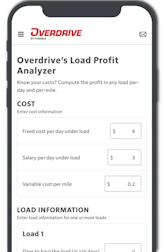Compensation and just how it's delivered to leased truck owner-operators and company drivers: it's a perennial topic of discussion that's perhaps gotten short shrift this year with so much attention to potential market upheavals that could result from the uptick in federal immigration enforcement.
Yet a couple results from some surveying of leased owners and company drivers conducted both by Overdrive and our sister publication CCJ stood out to me recently. They underscore a long-acknowledged disconnect between pay reality and preference OTR. For small fleet owners and other carrier management in the audience, the disconnect could signal a path forward to giving those who are on the front lines of your businesses what they want.
Comparisons between how owners and drivers are paid today and how they say they'd most prefer to be paid show one thing clearly: Compensation for all time worked ought to be a priority for any fleet owner who wants to deliver on employee drivers' desires.
The reality: Miles still dominate
As noted with the chart, in this combined dataset with CCJ, reflecting the responses of more company drivers than is typical for Overdrive's own singular surveys, forms of compensation with miles as a base account for a simple majority of pay packages. Hours pay for detention and/or other tasks is often enough added to that base, though only for about a fifth of miles-pay respondents.

Now, for the preferences.
What drivers want: Compensation for time
Compared to the reality in the first chart, asked what they truly want, the only percentages that fell here are those that don't directly account for time spent working. That is, flat miles (-19 percentage points) and percentage pay (-4 points).
Given the preponderance of leased owners in Overdrive's audience and growth and popularity of self-dispatch lease agreements over the years, the small decline for percentage illustrates the long preference of such owners, most likely to recognize the importance of a most-money-on-fewest-miles approach to load selection. Percentage pay with full self-dispatch gives owner-operators the best chance at meeting the goal of such an approach.
With decades of growth in self-dispatch options among carriers leasing owner-ops through the years, realities there probably come closest to matching operator preferences.
[Related: Percentage is kind for leased owner-operators, long after the rise of miles post-deregulation]
For company drivers and otherwise situated leased owners, though, the preference for pay for time is clear:
- Hourly: +7 points
- Miles/hours combo: +10
- Percentage/hours combo: +5
And +1 on the "Other" responses. As noted in the chart, that's where respondents largely earmarked salary or other weekly/monthly guaranteed-type pay, based at least in part on a unit of time rather than straight productivity. One respondent, though, underscored what so many of us want out of a compensation package, irrespective of how it's delivered, with a just single word there: "Plenty," he said.
Though tides have certainly turned in recent years against the very notion of any true macro-U.S.-trucking "driver shortage," talk to any small or large fleet owner and you'll hear about just how difficult they think it is to find truly reliable, dependable, safe and productive truck operators, and (crucially) get them to stick around. There are gobs of reasons an operator, whether employed or leased, might seek out the greener pastures, of course, but as that one-word commenter emphasized, compensation plays a huge part in it.
Fleet owners, you'd do best to heed what drivers are telling you.
[Related: An hourly future for driver pay?]
Find coverage from CCJ's annual "What drivers want" survey for more of the granular results from company drivers and leased owners via this link.
The long-running Partners in Business series is a coproduction of Overdrive and ATBS, with a comprehensive playbook for owner-operator careers, from start to finish. Access pieces of the Partners in Business series and browse the full playbook, now in a dynamic online-library format, via this link.













